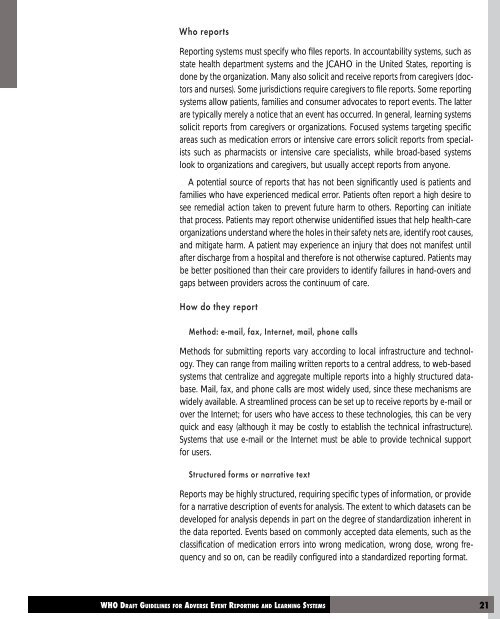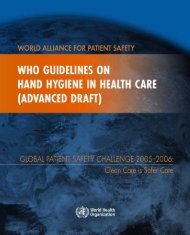Adverse event reporting.pdf
Adverse event reporting.pdf
Adverse event reporting.pdf
Create successful ePaper yourself
Turn your PDF publications into a flip-book with our unique Google optimized e-Paper software.
Who reports<br />
Reporting systems must specify who files reports. In accountability systems, such as<br />
state health department systems and the JCAHO in the United States, <strong>reporting</strong> is<br />
done by the organization. Many also solicit and receive reports from caregivers (doctors<br />
and nurses). Some jurisdictions require caregivers to file reports. Some <strong>reporting</strong><br />
systems allow patients, families and consumer advocates to report <strong>event</strong>s. The latter<br />
are typically merely a notice that an <strong>event</strong> has occurred. In general, learning systems<br />
solicit reports from caregivers or organizations. Focused systems targeting specific<br />
areas such as medication errors or intensive care errors solicit reports from specialists<br />
such as pharmacists or intensive care specialists, while broad-based systems<br />
look to organizations and caregivers, but usually accept reports from anyone.<br />
A potential source of reports that has not been significantly used is patients and<br />
families who have experienced medical error. Patients often report a high desire to<br />
see remedial action taken to pr<strong>event</strong> future harm to others. Reporting can initiate<br />
that process. Patients may report otherwise unidentified issues that help health-care<br />
organizations understand where the holes in their safety nets are, identify root causes,<br />
and mitigate harm. A patient may experience an injury that does not manifest until<br />
after discharge from a hospital and therefore is not otherwise captured. Patients may<br />
be better positioned than their care providers to identify failures in hand-overs and<br />
gaps between providers across the continuum of care.<br />
How do they report<br />
Method: e-mail, fax, Internet, mail, phone calls<br />
Methods for submitting reports vary according to local infrastructure and technology.<br />
They can range from mailing written reports to a central address, to web-based<br />
systems that centralize and aggregate multiple reports into a highly structured database.<br />
Mail, fax, and phone calls are most widely used, since these mechanisms are<br />
widely available. A streamlined process can be set up to receive reports by e-mail or<br />
over the Internet; for users who have access to these technologies, this can be very<br />
quick and easy (although it may be costly to establish the technical infrastructure).<br />
Systems that use e-mail or the Internet must be able to provide technical support<br />
for users.<br />
Structured forms or narrative text<br />
Reports may be highly structured, requiring specific types of information, or provide<br />
for a narrative description of <strong>event</strong>s for analysis. The extent to which datasets can be<br />
developed for analysis depends in part on the degree of standardization inherent in<br />
the data reported. Events based on commonly accepted data elements, such as the<br />
classification of medication errors into wrong medication, wrong dose, wrong frequency<br />
and so on, can be readily configured into a standardized <strong>reporting</strong> format.
















